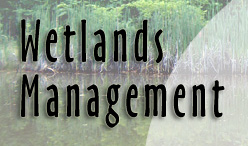Numerous fish
species rely on wetlands for all or part of their
life requirements. Wetlands serve as a nursery or
spawning grounds for a number of fish species. For
example, paddlefish, which are captured commercially
for their eggs (caviar) use forested wetlands as
nursery areas. Largemouth bass often spawn in
freshwater wetland margins around lakes. A number of
other game fish as well as many species of bait fish
use wetlands for reproduction.
Food production
Wetlands, many of which occur at the headwaters of
stream or the margins of lakes, also serve as the
food production areas for fish. Some fish and
crustaceans consume plants directly or eat
invertebrates that occur on the plants. However,
many fish species rely upon detritus, plant material
that is broken down by bacteria and invertebrates,
for their food. About one-third of the diet of
Atlantic menhaden, which is an important prey
species for a number of other fish species, such as
striped bass and bluefish, as well as numerous
waterbirds, such as egrets and herons, consists of
detritus. Wetlands can be considered the breadbasket
of the fish world.
Refuge and spawning areas
Wetland vegetation provides cover for many fresh and
saltwater species. Fish are able to hide from
predators among the dense herbaceous or woody
vegetation. Juvenile Chinook salmon spend 6 or more
months in tidal salt marshes, as they adjust from
the freshwater where they were born to the saltwater
where they live as adults.
|
|
Clean Water
Wetlands benefit almost all fish species by
helping to clean and purify the water.
Wetlands provide a natural filtration system
that reduces sedimentation and pollution.
Sedimentation, which is the deposition and
settling of suspended material, can be
detrimental to fish because it smothers
their eggs and does not allow them to get
oxygen. Wetlands can prevent sediment from
settling on the eggs of the many fish
species that require clean water and a
gravel or sand substrate. Wetlands also
serve as pollution conversion and storage
areas, by rendering many pollutants harmless
through uptake in plants or by chemical
conversions in the substrate, to make the
materials harmless to fish. See the
Water Quality Section
for more information on the influence of
wetlands on water quality. |
It is obvious that wetlands are critical for fish
and the anglers who catch them. For more information
on wetlands and fish view this document created by
the
National Oceanic and Atmospheric Administration. |

